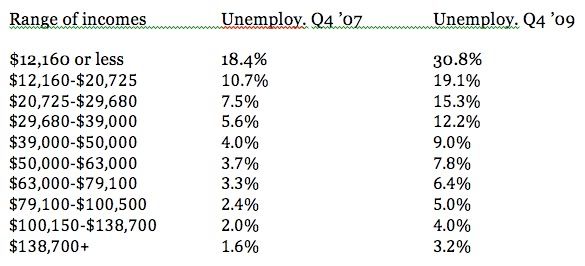Rich people still have jobs, poor people don't

Bob Herbert's column in yesterday's New York Times pointed out that the unemployment crisis is not hitting all parts of the income spectrum equally. I was pretty stunned by the numbers, which go like this:
| Range of incomes (by decile) | Unemployment rate |
| $12,160 or less | 30.8% |
| $12,160-$20,725 | 19.1% |
| $20,725-$29,680 | 19.7% 15.3% |
| $29,680-$39,000 | 12.2% |
| $39,000-$50,000 | 9.0% |
| $50,000-$63,000 | 7.8% |
| $63,000-$79,100 | 6.4% |
| $79,100-$100,500 | 5.0% |
| $100,150-$138,700 | 8.0% 4.0% |
| $138,700+ | 3.2% |
The data, which are for the fourth quarter, come from a new study (PDF) by Andrew Sum, Ishwar Khatiwada and Sheila Palma at Northeastern University's Center for Labor Market Studies. The researchers conclude that "what has been missing from the public debate over the labor market crisis is an honest and detailed analysis of which American workers have been most adversely affected by the deep deterioration in labor markets."
Furthermore:
At the end of calendar year 2009... workers in different segments of the income distribution clearly found themselves in radically different labor market conditions. A true labor market depression faced those in the bottom two deciles of the income distribution, a deep labor market recession prevailed among those in the middle of the distribution, and close to a full employment environment prevailed at the top. There was no labor market recession for America's affluent.
I didn't post about this yesterday because I had a question about the extent to which people fall into lower income brackets precisely because they are unemployed. Lose your job for a year, and there's probably a decent chance you've gone from living in a household that makes $60,000 a year household to one that makes $30,000, right? Then that's where you get counted as unemployed.
I emailed Andrew Sum and he wrote back:
The paper is based on family income including all other members of family and includes theoretically all cash transfers including unemployment insurance. It is true that a person who had a job a year ago and lost it and has no [unemployment insurance] coverage or other income can get pushed down to a much lower income but they are an overwhelming exception.
We ran this model before the recession started and results show overwhelmingly that low income workers were far more adversely affected. There are few job losses at top.
In other words, even in good times unemployment hits people in lower income brackets harder. I imagine that might have to do with the prevalence of temporary and seasonal work.
UPDATE: Here is how the numbers compare between the fourth quarter of 2007 and the fourth quarter of 2009.

The current economic climate has certainly exacerbated the effect. And that is true not just for unemployment, but also for underemployment (people working part-time even though
they'd rather be working full).
More from the report:
Workers in the lowest income households faced an underemployment rate of nearly 21%... The incidence of these underemployment problems also fell steadily and considerably as we move up the income distribution, dropping to 6.1% for workers in the fifth decile to 3.6% in the eighth decile and to a low of only 1.6% for those workers in the top decile of the income distribution. Employed workers in the lowest income decile were 13 times as likely to be underemployed as workers in the top decile of the nation's income distribution in the fourth quarter of 2009. Again, workers at the bottom and top of the income ladder were encountering dramatically different labor market problems. Source



1 Comments:
Hi! I spend a lot of time in the internet and while surfing on the net i visit your blog. I am really impressed with your Knowledge empowerment skill based content which will be really important. Good work, keep writing more and share with us.
SEO India
Post a Comment
<< Home